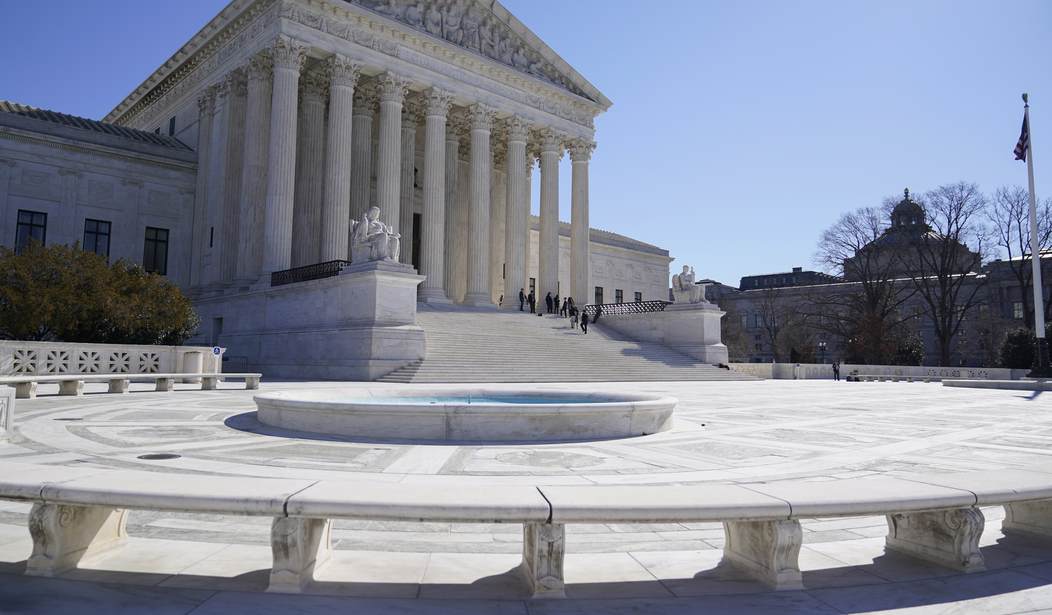A long-time tactic of the left is to try to gain through tame and stump-broke judges what they can’t win at the polls. Never does this become more obvious than in matters of voting procedure and redistricting. In 2020, we were deluged with stories of single judges willy-nilly changing voting procedures based on some fanciful notion that COVID prevented the orderly conduct of elections. In Wisconsin, we saw nursing homes with a 90+ percent return of “absentee” ballots, when 90+ percent of the nursing home residents were not capable of casting a vote.
We saw voting extended to allow mailed ballots to arrive. There were places where ballots were mailed to all voters, no matter if they’d requested them. This numbskullery was not the work of state legislatures passing laws signed by the governor. This was the direct result of judges deciding that they had the authority to interfere in elections.
Likewise, we see the same shenanigans pulled with redistricting. The left waits until the penultimate hour before challenging congressional districts drawn according to constitutional methods. This inevitably kicks the decision to a judge who invariably decides that the Democrats need more safe districts.
Today, the US Supreme Court delivered two victories to the Democrats in redistricting. One case comes from North Carolina and one from Pennsylvania. Both cases involve a state legislature following the process laid out in the state constitution being sandbagged by a judge who has a better idea. The quotes are from SCOTUSBlog.com.
- North Carolina
The North Carolina dispute, Moore v. Harper, began when the state’s legislature drew a new congressional map based on data from the 2020 census. The map, which was enacted on Nov. 4, 2021, likely would have allowed Republicans to pick up two seats in the state’s congressional delegation – giving them as many as 10 of the state’s 14 seats. Non-profits and a group of mostly Democratic voters challenged the map in state court as an illegal partisan gerrymander that violated the state’s constitution.
On Feb. 4, the North Carolina Supreme Court invalidated the map and sent the case back to a state trial court. The trial court rejected a new map proposed by Republican legislators and instead required the state to use a map that had been created by court-appointed experts. That map would be less favorable to Republicans. On Feb. 23, the state supreme court refused to put the expert’s map on hold.
- Pennsylvania
Like the North Carolina case, the Pennsylvania dispute, Toth v. Chapman, originated with the state’s effort to redraw its congressional map after the 2020 census, including to reflect the state’s loss of one of its 18 seats in the House. The state’s Republican-led legislature approved a map that would have created nine likely Democratic seats and eight likely Republican seats, but the state’s Democratic governor, Tom Wolf, vetoed the map. A group of Pennsylvania voters also filed a lawsuit in December 2021, asking the state courts to adopt a different congressional map, known as the “Carter Plan,” that (among other things) would create 10 Democratic-leaning seats instead of nine and place two Republican incumbents in the same district.
In early February, the Pennsylvania Supreme Court – where Democrats hold a majority – intervened in the litigation and instructed Judge Patricia McCullough, the state trial judge to whom the litigation had been assigned, to submit, by Feb. 7, a report recommending both a redistricting plan and any revisions to the election schedule that would be required. McCullough recommended that the state use the legislature’s map. On Feb. 23, however, a divided state supreme court adopted the Carter Plan instead, and it directed state election officials to implement a new election calendar to accommodate the change.
Both state legislatures appealed to the US Supreme Court.
The Pennsylvania legislature argued that not only had the state supreme court illegally taken over the redistricting process, but it had also changed the filing deadline for candidates as well. The US Supreme Court refused to hear the case.
Toth v. Chapman by streiff on Scribd
The North Carolina case’s refusal indicates that a plurality of this court are far from being satisfied with the judiciary acting as though it was a state legislature. In its appeal, the North Carolina legislature directly challenged the authority of the state supreme court to get involved.
The Republican legislators in the North Carolina case urged the Supreme Court to step in to block what they characterized as a “usurpation” of the legislature’s power under the Constitution to regulate congressional elections. If the elections are allowed to go forward under the new, court-created map, the legislators argued, both the legislators and the voters will suffer permanent and irreparable harm. Not only will the courts have seized the legislators’ power, but the voters will have been forced to choose their representatives in Congress through unconstitutional procedures. The legislators also relied on another election-law doctrine, known as the Purcell principle, which is a presumption that courts should not change state election rules shortly before an election.
This rejection came with an opinion authored by Justice Alito, joined by Justices Thomas and Gorsuch. Even though Justice Kavanaugh does not sign onto Alito’s dissent, he agrees with it but opines it is too late for action on the 2022 election cycle.
Alito Dissent Toth v. Chapman by streiff on Scribd
In a brief order on Monday afternoon, the court declined, without explanation, to intervene in the North Carolina case. Alito dissented from that ruling in a four-page opinion that was joined by Thomas and Gorsuch. Alito described the independent-state-legislature theory as “an exceptionally important and recurring question of constitutional law,” and he suggested that the justices “will have to resolve this question sooner or later, and the sooner we do so, the better.” Alito expressed sympathy for the Republican legislators’ position, writing that if the Constitution’s language “is to be taken seriously, there must be some limit on the authority of state courts to countermand actions taken by state legislatures when they are prescribing rules for the conduct of federal elections.”
Salon’s legal expert and all-around Jack-Russell-chasing-a-frisbee when it comes to writing about the conservative side of the Supreme Court, Ian Milhiser, sees possible doom.
Republicans appealed both court-draw maps to SCOTUS. They claimed that these plans violated the U.S. Constitution’s elections clause, which says that the “manner” of federal elections “shall be prescribed” by the “legislature.” For at least a century, SCOTUS has read this language to give other organs of state government a say in election law. But conservative scholars have devised a theory known as the “independent state legislature doctrine” that would give legislatures complete control over elections, including voting rules and redistricting. Under this theory, state constitutional provisions governing elections would be null and void, and state courts would have no power to intervene in election disputes. The legislature alone would set the rules—and, in extreme versions of the theory, even dictate the outcome of an election.
…
The Supreme Court has never endorsed this doctrine, and has explicitly rejected it as recently as 2015. There is a good reason why: It contradicts the original meaning of the elections clause as well as historical practice reaching back to the early days of the republic. A mountain of evidence proves that Framers never intended to give states lone authority over federal elections, and instead expected state constitutions to impose substantive limits on election law. Exhaustive research demonstrates that—aside from a few opportunistic arguments raised by congressional partisans in the 19th century—state legislatures, state courts, federal courts, and Congress have all rejected the doctrine for more than two centuries.
(Editor’s note: you can ignore his links. They go to law journal articles and blog posts by leftwing lawyers, and should be viewed as agitprop rather than an attempt at creating a factual history.)
By contrast, the North Carolina case teed up the elections clause issue perfectly, and thus divided the court. Because it’s a shadow docket order, we don’t know exactly how each justice voted, but it appears that Chief Justice John Roberts and Justice Amy Coney Barrett joined the liberals in turning away the challenge without comment. Kavanaugh wrote that Republicans had “advanced serious arguments on the merits” but concluded that it was too late for the federal judiciary to intervene, citing the Purcell principle. Alito, joined by Thomas and Gorsuch, dissented, declaring that the North Carolina Supreme Court had likely violated the elections clause by striking down the legislature’s congressional map.
Alito’s dissent, which wholeheartedly adopted the independent state legislature doctrine, is a master class in disingenuousness. He omitted more than a century of SCOTUS precedent rejecting the doctrine. He ignored the Purcell principle, which he has consistently used to halt lower court orders protecting voting rights. He disregarded the North Carolina legislature’s express approval of judicial supervision over redistricting. And he dismissed the North Carolina Supreme Court’s decision as mere “legislation”—even though the majority engaged in an exhaustive overview of the state constitution’s guarantee that “all elections shall be free.”
“This guarantee of ‘free elections’ dates all the way back to the North Carolina Constitution of 1776,” Alito wrote, “but for 246 years that language was not found to prohibit partisan gerrymandering.” Implying that the court’s Democratic majority was motivated by politics rather than law, he fumed: “Only this year did the State Supreme Court change course and discern in the State Constitution a judicially enforceable prohibition of partisan gerrymandering.” (The long dormancy of a constitutional provision did not stop him from adopting a novel reading of the Second Amendment in 2008.)
I think this decision has to be read in line with the Supreme Court’s decision in the recent Alabama redistricting case, see Alabama Appeals the Rejection of Its Redistricting Map and the Left May Get More Than It Wanted or Expected and Why We Shouldn’t Fear Chief Justice John Roberts as More Clouds Loom Over the Future of Racial Gerrymanders and the Voting Rights Act. With various “voting rights” issues, just like with abortion and gun control, the current majority on the court acts as though it would rather create some bright lines for lower courts to follow so the Supreme Court doesn’t get a steady stream of similar cases. The Alabama case referenced above made it clear that the Supreme Court did not want court challenges to voting laws or redistricting to go on while a state was preparing for a primary election.
The Supreme Court has signaled that it may be getting out of the abortion business (Does Justice Sotomayor’s Intemperate Rant at Her Colleagues Indicate That She Knows Roe v. Wade Is About to Be Overturned?). The challenge to a New York gun control law hinted that many restrictions on the right to carry firearms might be about to go away (Supreme Court Conservatives Maul New York’s Restrictive Concealed Carry Law in First Major Second Amendment Case in a Decade).
Milhiser is probably correct that there are four votes to severely limit the role of courts in drawing congressional districts. Can those four bring along Amy Coney Barrett? I suspect, given what we’ve seen so far, that they can. If that materializes, we can rely on John Roberts joining the majority so he can write the opinion and limit the damage that Alito is prepared to do.














Join the conversation as a VIP Member